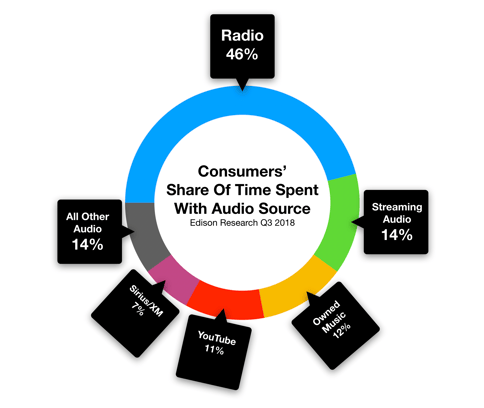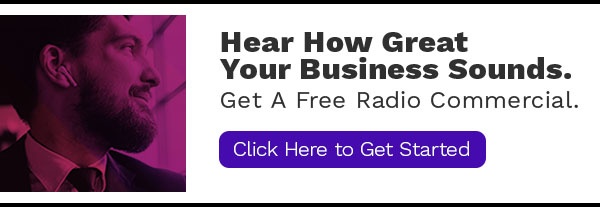 Radio advertising is processed by the brain profoundly faster than visual advertising. This is valuable news for Tampa Bay business owners who depend on advertising to market their goods and services.
Radio advertising is processed by the brain profoundly faster than visual advertising. This is valuable news for Tampa Bay business owners who depend on advertising to market their goods and services.
Local consumers can recognize the first few notes of Jingle Bells five times faster than they can identify a picture of Santa Claus. That's because it takes the human brain 5/100th of a second to process sound. On the other hand, it takes a full quarter of a second to process visual stimuli.
This difference in processing time may seem inconsequential. But, for a business owner who is fighting to inject her advertising message into the mind of a potential customer, that .20-second gap can be the difference between success and failure.
During that chasm between sound and sight processing, consumers will be inundated with by 2,200,000 other pieces of data that will compete for the brain's attention. Because brains are only capable of dealing with about ten pieces of data every quarter second, the last one is, as they say, a rotten egg.
For a small business owner to win the battle of the brain, then, it must first seize a consumer's ear. By any, measure, advertising on Tampa radio stations dominates the ear.
Last week, according to Nielsen, significantly more consumers tuned-in to a Tampa radio station than watched local TV, read a local newspaper, or logged-on to a streaming audio site like Pandora or Spotify.
Most impressively, among audio-only platforms, radio, by far, command the largest share of a consumer's ear.
There's another scientific reason for Tampa Bay small business owners to put their money where the ears are. It's called encoding.
Last year, Brainsights, a research company that uses neurological, bio-metric, and non-conscious data to learn how consumers make decisions, set out to compare the advertising efficacy of different media. The study was commissioned by Canadian Broadcast Sales.
Researchers used EEG technology, that records the electrical activity of the brain, to track individual reactions to radio content. Respondents were exposed to 32 commercials across various categories ranging from automotive and finance to entertainment and personal care. The electrodes measured subconscious engagement across three key variables: awareness, connection, and encoding.
These three areas of engagement measured are the states of mind that influence advertising results.
The study found that radio, TV, and digital ads performed comparably in awareness and connection. When it comes to encoding, however, radio commercials proved far more effective than other media.
What is encoding? It's the process our brains use to store and recall information. For the information in ads to influence a sale, it must be properly encoded.
Advertising on Tampa Radio Rules The Brain
According to the study, radio's ability to affect encoding was 8% greater than all general advertising; 21% greater than television advertising; and 4% greater than digital advertising.
Radio's encoding advantage is even more evident when individual product categories are considered.
For financial services, for instance, radio produced 30% more encoding than the general advertising benchmark for the study. For e-commerce categories, radio's encoding results were 35% higher.
Local Ad Recall, a research company that measures the effectiveness of advertising, found that brand recall was five times higher for companies that advertised on radio versus the companies that did not.
Consequently, Tampa Bay small business owners who advertise on radio have a much better chance of being recalled and, therefore, frequented by prospective customers than companies that do not advertise on radio.
Hundreds of local business owners understand the power of putting their marketing messages directly into the ears of consumers by advertising on Tampa radio stations.
Radio Advertising Is A Sound Investment
 "Radio advertising is a huge part of our success," says Trent Taucher. His family has owned Budget Heating and Air Conditioning since 1992. "The constant repetition of our unique message on Tampa radio stations drives new customers through a door every day."
"Radio advertising is a huge part of our success," says Trent Taucher. His family has owned Budget Heating and Air Conditioning since 1992. "The constant repetition of our unique message on Tampa radio stations drives new customers through a door every day."
The company began advertising in the year 2000 when the company transitioned from typical sales and installation company to just selling air-conditioning units from its warehouse directly to consumers and contractors.
"The success of our new business model depended largely on word-of-mouth. We quickly generated plenty of it with radio advertising," says Mr. Taucher. "We used our radio advertising to tell customers how to find us and how much money they would save buying direct from us. Every day, someone would say they would have never known we were here."
One day, in 2010 the company discontinued its radio advertising. "We didn't have, at the time, a way to track our return-on-investment from our ads," says Mr. Taucher. "That's about the time we started investing in pay-per-click advertising online. With PPC we could link our advertising costs to sales."
The negative effect of pulling out of radio was quickly apparent. "Almost immediately," says Mr. Taucher, "we watched as our store traffic diminished. When we stopped advertising on Tampa radio, we really lost an important part. of our business."
In 2017, Tampa radio made its way back into Budget Heating's advertising budget. "We started with a schedule on Spanish radio, says Mr. Taucher, "to expand our awareness among Tampa's growing Hispanic community."
"After about three months of radio advertising, our store traffic shot-up," says Mr. Taucher. "That's when the ads really started paying for themselves. So much so, that in 2018 we increased the number of radio stations we advertise on."
Tampa radio and PPC now comprise the majority of Budget Heating's advertising expenditures. "We use PPC strictly for conversions," says Mr. Taucher. "Radio is about creating word of mouth and staying top of mind. Radio advertising is much more of a branding tool for us."
Another area small business has seen similar results.
 Ana Delicias Bakery in Tampa is not just a small business. It's a tiny, family-owned business with big ambitions. Advertising on local radio is helping the business raise the dough to grow.
Ana Delicias Bakery in Tampa is not just a small business. It's a tiny, family-owned business with big ambitions. Advertising on local radio is helping the business raise the dough to grow.
After being in business for five months, Ana Delicias Bakery ran its first radio commercial.
"Radio advertising is not an expense for us, It is an investment," says Paula Tavarez who co-owns the bakery with her cousin Ana Lizardo. "That investment has paid off."
"We began seeing a lot of new customers," adds Ms. Lizardo. "We would ask them how they learned about our bakery and they would tell us that they heard about it on the radio."
Tampa radio's ability to reach well beyond the local community proved to be a benefit for the bakery as well. "We started to see customers from Brandon and St. Petersburg," says Ms. Lizard. "People were driving from 35 minutes away to buy our cakes."
Ana Delicias first radio advertising campaign lasted four weeks. "When the commercials started," says Ms. Tavarez, "we saw a surge in our business. When the commercials stopped, then our business slowed down."
As a result, the bakery now uses radio advertising on a regular basis.
"Our cash register is the true measurement of how well advertising on Tampa radio works," says Ms. Tavarez. "When we advertise, we bring in more customers."








